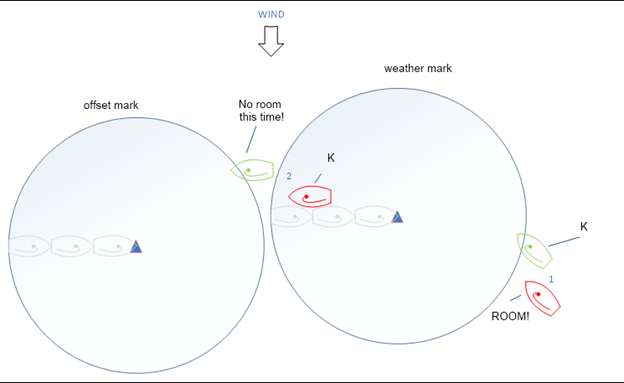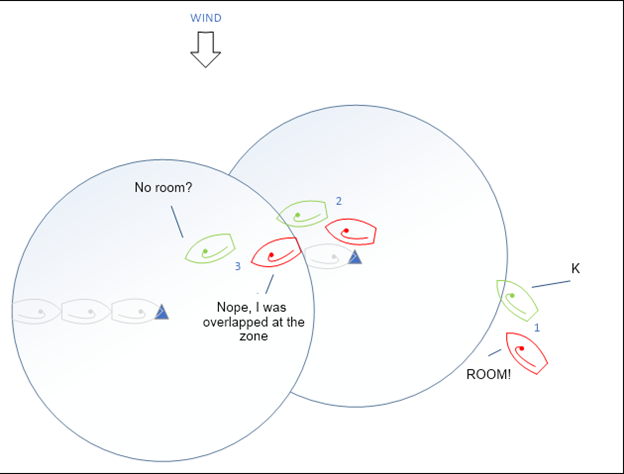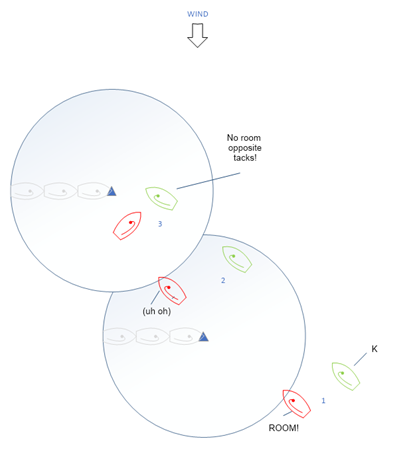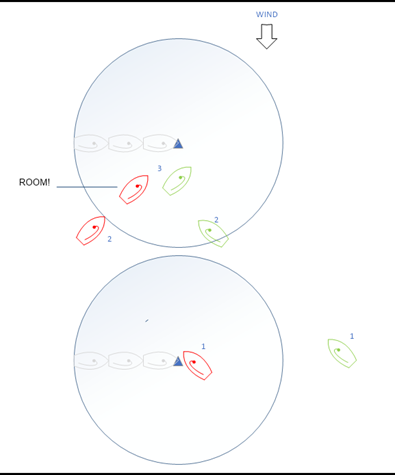The offset mark can be a confusing place for the rules. Lots of things tend to be happening very fast – we’re bearing off, getting ready to hoist, and the rules situation is sometimes murky.
Does the offset mark count as a mark? Do the two marks count as some sort of long continuous mark? If I get room at the weather mark does that automatically mean I get room at the offset mark?
Let’s see:
In the racing rules of sailing, the definition of mark is:
An object the sailing instructions require a boat to leave on a specified side.
So is the offset mark mentioned in the SIs? Yes
Are we required to leave it on a specified side? Yes
So is it a mark? YES!
Since it’s a mark, Rule 18 applies just like at any other mark.
Is the offset mark its own mark, or does it just count as an “extension” to the regular weather mark?
Nothing in the rule book says anything about an offset mark being a special kind of continuous mark, so NO, it counts as a totally separate mark.
The key concept is that Mark Room is determined separately for each mark. Mark room is determined at the snapshot in time when the first boat reaches the zone for that mark. In this case, we look at whether there’s an overlap at each mark’s zone independently – both the zone around the weather mark, and the separate zone around the offset mark.
Here’s some scenarios to help clarify:
Scenario 1 – the simple case

Red is overlapped inside Green on the starboard tack layline to the weather mark (position 1). She gets room to round. Once mark room is given, both boats bear off and head to the offset mark. There is no change in overlap – Red remains overlapped inside as the first boat reaches the zone for the offset mark (position 2), so she also gets room to round this mark.
Scenario 2 – breaking the overlap

As before Red is overlapped inside Green on the starboard tack layline to the weather mark, but this time slightly further behind (position 1). She gets room to round the weather mark. Once mark room is given, both boats bear off and head to the offset mark.
After the weather mark Red is no longer overlapped with Green and has fallen astern. When the first boat (Green) reaches the zone for the offset mark (position 2), there is still no overlap. This time Red does not get room at the offset mark.
Scenario 3 – marks are close together
The rules we learned about in scenarios 1 and 2 apply whether or not the zone for the offset mark and the weather mark overlap. In scenario 3 below the offset mark is set very close to the weather mark. The same rules apply; if the overlap is broken inside the zone of the offset mark (position 3 below), then the inside boat still gets room to round the mark as usual as long as they were overlapped at the snapshot in time when the first boat enters the zone of the offset mark (position 2 below).

The same thing applies even if the offset is set so close that the zone for the offset mark extends to beyond the weather mark. This would be a slightly confusing situation as you need to consider the overlap situation for the offset mark before even rounding the weather mark. Luckily this shouldn’t normally be the case, as the offset mark is there to create some space between boats beating upwind and those bearing off to go downwind. But some race committees like to put the offset mark real close.
If the offset mark does happen to be very close, while technically each mark has its own zone and are independent, practically it might be easier to consider this as one continuous mark. Assume you owe a boat mark room at the weather mark. You would have to simultaneously give the other boat mark room to sail to the mark AND then somehow get inside or ahead before the zone of the next mark. Not impossible, but in practice likely hard to make happen. Also recall if there is doubt whether an overlap was established or broken in time - it shall be presumed it wasn’t (rule 18.2e).
Scenario 4 – offset mark is upwind of weather mark, one boat tacks
Sometimes, either because it was set poorly or because of tide or a large windshift, the offset mark ends up further upwind than the weather mark, and some or all boats need to tack to make the offset mark.

In this case, again all the usual rules of Part 18 apply to the offset mark in isolation. If boats are on opposite tacks on a beat to windward, mark room does not apply (Rule 18.1a). So even if an inside overlapped boat had room at a weather mark (position 1), and remain overlapped at the zone of the offset mark (position 2) – if they then need to tack to fetch the offset mark but the outside overlapped boat does not, the inside boat is not entitled to room (position 3).
Scenario 4 - offset mark is upwind of weather mark, both boats tack
If the offset mark is so far upwind that both boats need to tack, then Rule 18 turns on again the second that both boats are on the same tack. In this scenario mark room does not apply at position 2 (boats are on opposite tacks), but Rule 18.2(a) kicks in once green also tacks to port (position 3), and as red is overlapped inside she gets room. Note that this situation also applies at a normal weather mark rounding.

Hoist!
-written by Reto, with rules input from David Pyron (thanks David!)

